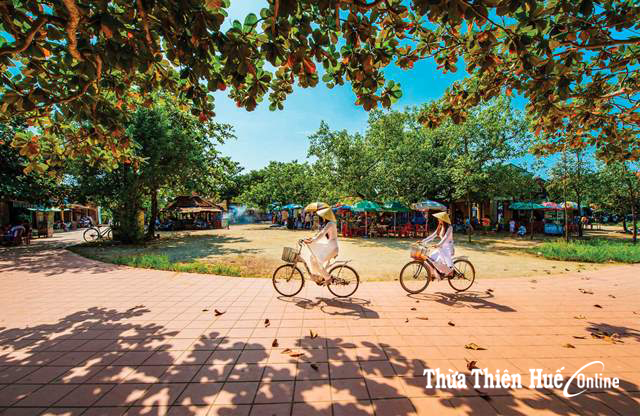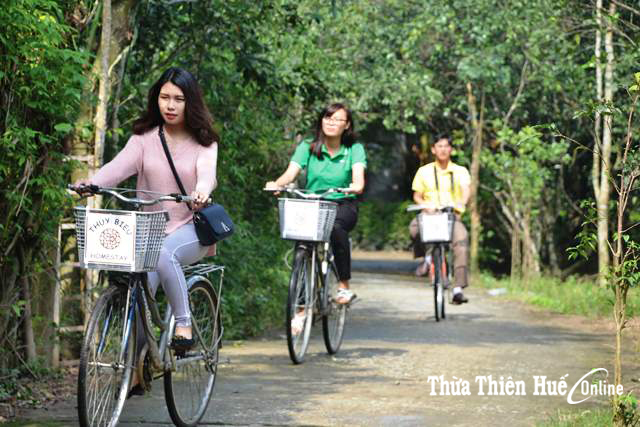The general plan cycling and free/low-cost bicycle sharing program in Hoi An City project won the Global Urban Transport award by the Federal Ministry of Economic Cooperation and Development of the Federal Republic of Germany. The award ceremony took place in the City of CLeipzig (Germany) from May 22-25.

Hue School Girls. Photo: Song Khanh
Hoi An’s Office of Culture and Information, the designing unit of the project, said that the project is focused on addressing the two key issues of road safety and public health by developing a comprehensive plan for an eco-friendly and sustainable green transport system with bicycle as a popular means of transport.
According to the plan, Hoi An will develop a free/low cost bicycle sharing program by connecting the existing bicycle programs of the hotels in the City. This plan was based on the "Eco city" program implemented in Hoi An since 2009. Hoi An claims to be aiming at an "eco-friendly city", where all cultural and historical values are preserved, tourism is well developed and the local people’s quality of life is improved. Bicycle is recommended as a means of travel as it proves to be proper to the travel distances in the city.
Experts says that this model can be applied in small and medium sized cities with similar characteristics. If Hoi An can do it, can Hue do it?
Mr. Nguyen Ngoc Dung, a Hue-born architect living in Ho Chi Minh City, is the author of the book Lang thang Phố thị (Wandering in the City) and a strong critic on urban planning forums in Vietnam. More than ten years ago, in a talk about the future of Hue, he said that Hue had perfect quality to become a "vehicle smoke-free city".
Hue is a city of small size and with a small population, short travel distances, evergreen space, and slow pace of life ... For these reasons, the City should choose trams as a public means of transport, and bicycles as individual vehicle; and at the same time, gradually phases out motorcycles and limit private cars to a certain reasonable number.
These are simply recommendations to consider; the specific solutions will evidently be thought of by the professionals. There have been people showing their disagreement to this idea with strong arguments and also their rejection of the suggestion with surprisingly strong reasoning. But if people will back down whenever they find it too difficult to deal with some complicated problem it is easier for them to back down than to march forth and try overcome setbacks one might face in a project.
When hearing of plan of the city authority to transform the “Back Packers Streets” Pham Ngu Lao and Chu Van An into pedestrian streets, many people said that it would be very difficult to carry the plan out; yet the plan was well implimented after all. The plan to transform Hue into “a bicycle city" faces the same reaction: if you think it is difficulf, then it will be impossible to do!

Hue will look safer and sounder, and the city will appear more spacious when everyone travels by bike.
I myself do think that it is difficult make the change too, but this is not an impossible mission to do as the Province has defined Hue as a “heritage, cultural, ecological, landscaping, and environmentally friendly” city. Another reason is that Hue has also been recognized by the World Wildlife Fund (WWF) as a national green city of Vietnam – the city is taking the lead in sustainable development and friendly attitude toward the environment.
According to Assoc. Prof. Luu Duc Hai, Vice chairman of the Vietnam Urban Planning and Development Association, one criterion for a city to be defined as an eco-city is that its inhabitants can get access to most basic public services: on foot, by bike and by public transportation.
The expert also said that one of criteria for eco-cities is that urban transportation ought to set priorities for the means of travel as follows: walking, bicycles, trams, subways, or buses; and finally cars. If Hue determines to become an eco-city while people still keep on travelling by motorcycle or car, the goal of the plan may never be achieved.
Amsterdam, Copenhagen, Paris, Berlin, Barcelona, Tel Aviv, Rio de Janeiro ... are the world’s well-known bicycle cities. Of the mentioned cities, Amsterdam of Netherlands shares many similarities with Hue: Both cities are ancient towns, have small population, own lots of heritages and hide themselves in nature. The local dwellers as well as tourists are not fond of travelling in the cities by car for the reason that car parking fees are too high, and especially nearly all the streets are old and narrow, which makes them, when travelling by car, feel uncomfortable to enjoy the surrounding landscape.
Consequently, more than 60 % of the local people and tourists choose bikes. There are approximately more than 1.2 million bicycles in Amsterdam. The number is even bigger than the city's population (around 750,000).
Architect Dang Minh Nam, Director of Thua Thien Hue Construction Planning Institute is very fond of the idea about "Hue – a bicycle city". According to his view, the idea can be first applied inside the Citadel, where he and his colleagues are working to turn the place into a "relaxing place”.
Nguyen Dinh Anh Khoa, a young man with the nickname "Mr. Bicycle", is also excited about this idea. He has already had the idea to develop an eco cycling tours like in Amsterdam, but as he still faces with some difficulties, he is considering a more suitable option. Once the restoration of the Citadel finishes, he will open this type of tour for tourists to travel on and around the Imperial City’s ramparts.
The Department of Tourism is also embarking on a project to build a road for bike riders, and the itinerary Khoa suggests is the one along the Perfume River from Phu Van Lau to Thien Mu pagoda ... Though this is just an initial suggestion, the idea about a "Bicycle City" is of great interest.
Story: Minh Tu, Photos: Duc Quang
